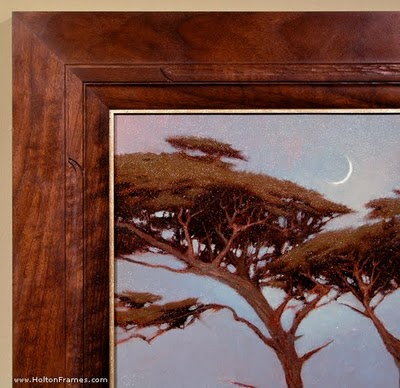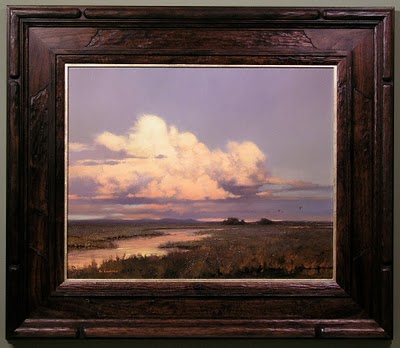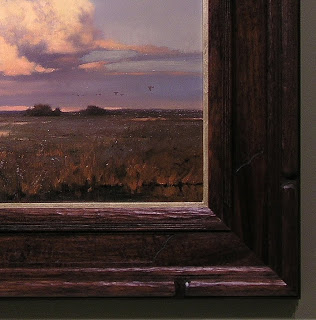Enjoyed framing this 12″ x 14″ oil for Kevin Courter, now at New Masters Gallery in Carmel. Chose walnut for its color (used a light stain to get the harmony just right) and because it’s good for carving. Chose a flat profile, since it’s a flat composition, but at the sight edge it’s got a very subtle convex, or ovolo, form echoing the form of the treetops cradling the moon. The frame similarly cradles the painting. The carved pattern takes its cue from the crescent moon and the branches. The narrow slip with lemon gold leaf matches the moon.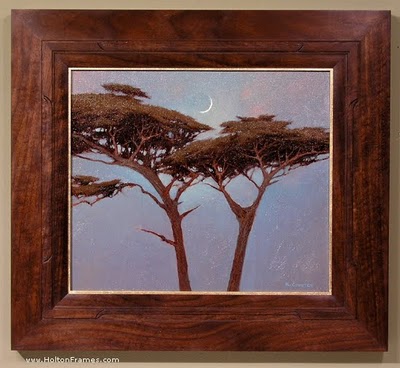
Archives
Framing Paintings—I: Kevin Courter’s “Colusa Sunset”
“All true art is praise,” as John Ruskin said, getting right at the heart of picture-making (and blowing the top off a lot of pretentious blather about art, too). Last fall Kevin Courter brought in this work of praise, a 16″ x 20″ oil on linen, less than 2 weeks before our show, “A Heaven in the Eye” was to open. It’s a stunner, as you can see, and to a frame-maker an inspiration. My enthusiasm and the extra focus imposed by the deadline spurred me to produce one of my favorite recent pieces.
Kevin says this is near Gray Lodge Wildlife Area off I-5 in Colusa County — a place I haven’t been to but which a number of customers praised to the skies (how else to say it?) for the astonishingly huge flocks of geese and rare species to be seen there. It’s a place where you can feel as though bird life is as strong as ever; as if life everlasting still means something (as it surely does, after all); as if we can still witness nature’s eternal beauty (which we can). It’s some place to praise.
Most of the framing we do is more restrained, simple, frank. But one thing a frame legitimately does is sustain and amplify the praise the picture has started, and this praise can be as lavish as you like, so long as the frame remains subordinate to the picture and obeys the first law of the universe: the law of help. Or, to borrow William Morris’s words, “all this is not luxury, if it be done for beauty’s sake, and not for show.”
There’s a very important distinction between this use of decorative treatment to enhance a painting and the illegitimate praise the frame has frequently been enlisted to lavish on, not the subject of the picture but the picture itself—the picture as trophy, as symbol of status and wealth. In this role the frame is often oddly blind to the character of the picture. Is a slick gold frame ever well-suited to a painting of a cow or a weather-beaten barn—or a muddy river bank? That’s the frame as unflattering flatterer and sycophant, not as friendly home or accompanist.
The frame’s praise of nature begins with suitable materials, and this was a beautiful piece of American Black walnut, with rich native color (a little stain was used to get the color harmony just right) and a bit of interest in the grain but still even and workable for carving. I chose walnut for the cool brown native color and the tight grain which is better for detailed carving. Also, our most frequently used wood, quartersawn oak, has strong figure that can compete with this more refined kind of carving.
It’s hard to take frame designs to this level on smaller or more impressionistic or on tonally subdued paintings. But a work as strong as this one leaves room for the frame-maker to be more free. This piece was large enough, had enough tonal power, and was simply so reverential in spirit that it called for a more elaborate frame. It is also detailed and highly rendered enough to suggest more detail in the frame.
The key to having a frame be more elaborate without upstaging the painting is the harmony of the elements (line, form, material, color, texture) and economy in their use: every element and detail should have a reason for being—should be justified by the painting, and echo an element or detail in the painting. In other words, key to keeping the frame subordinate to the painting is having nothing in the frame that isn’t a complement to, or echo of, something in picture. In this case, the primary form in the painting is the cloud. This frame’s response to that form is obvious (the carved bead with rounded stops at the corners, the scallop stops on the flat). The amount and strength of line in the frame must be economical as well—constrained by what suits the painting. I had fun picking up the fine grasses in the foreground with fine carved lines at the frame’s sight edge.
I don’t expect to ever make another frame exactly like this, because there’ll never be another painting exactly like this. That’s one of the tests of a truly living art form: it’s alive to the other arts—and to the world—-in specific ways. But it’s not hard to do. It just requires taking the time to truly see and appreciate the adjacent arts. And it demands that we work with both freedom and humility in our service to the other arts.
It helps, too, to have inspiration, which in this case was provided by Kevin Courter and the landscape of Colusa County, California.
Wedding Gifts
With wedding season approaching I thought I’d put out a couple of examples of pieces we’ve recently done as wedding gifts. This picture’s framed close in a simple walnut “Hudson” frame with a gilt slip. Walnut, which is a tight-grained wood, has a smooth finish which suits the finish of the photo. The form gives a picture some space but has a graceful shape that su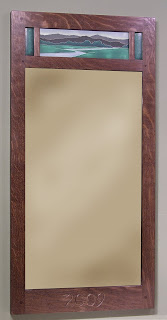 its the figurative subject matter. I think we struck the right balance between the formality of the image and occasion and the informality of the rustic porch (it’s actually a kind of stage set at the Museum of the New South in Charlotte, NC).
its the figurative subject matter. I think we struck the right balance between the formality of the image and occasion and the informality of the rustic porch (it’s actually a kind of stage set at the Museum of the New South in Charlotte, NC).
The second example is a mirror made for a customer who found an image in tile that she liked as an appropriate image for newlyweds, and wanted it integrated into a mirror to give as a wedding gift. (Mirrors make great wedding gifts, because when you get married you have to watch yourself.) I also carved the year of the wedding, 2009, into the bottom. The tiles are by Motawi Tileworks (the two on either side of the landscape tile are actually glaze samples). Made in quartersawn white oak (Weathered Oak stain) it measures about 38″ x 18-1/2″.
Carved Walnut
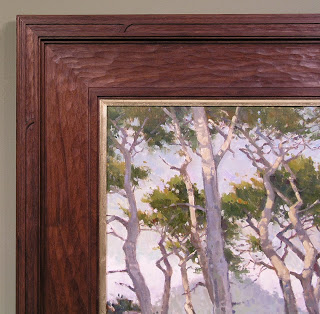 Of all the woods we use, we tend to emphasize quartersawn white oak. But walnut has always been a big favorite too, especially for carving. In preparing for the Paul Kratter show in June, the painting we decided to use for the publicity suggested walnut. Here’s a corner detail of the frame, which is a compound design, meaning it’s composed of more than one molding. This one has a cap molding as well as a liner. The liner has pale gold leaf laid directly on the walnut so the grain comes through.
Of all the woods we use, we tend to emphasize quartersawn white oak. But walnut has always been a big favorite too, especially for carving. In preparing for the Paul Kratter show in June, the painting we decided to use for the publicity suggested walnut. Here’s a corner detail of the frame, which is a compound design, meaning it’s composed of more than one molding. This one has a cap molding as well as a liner. The liner has pale gold leaf laid directly on the walnut so the grain comes through.
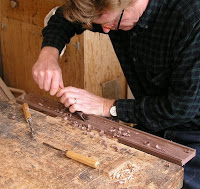
The color of walnut harmonizes well with many pieces because it’s rich without being too intense. We typically stain it – this one has a light stain – to mute it even further.
We use walnut frequently for drawing frames (i.e., narrow profiles), but it’s often great on paintings and other items.
